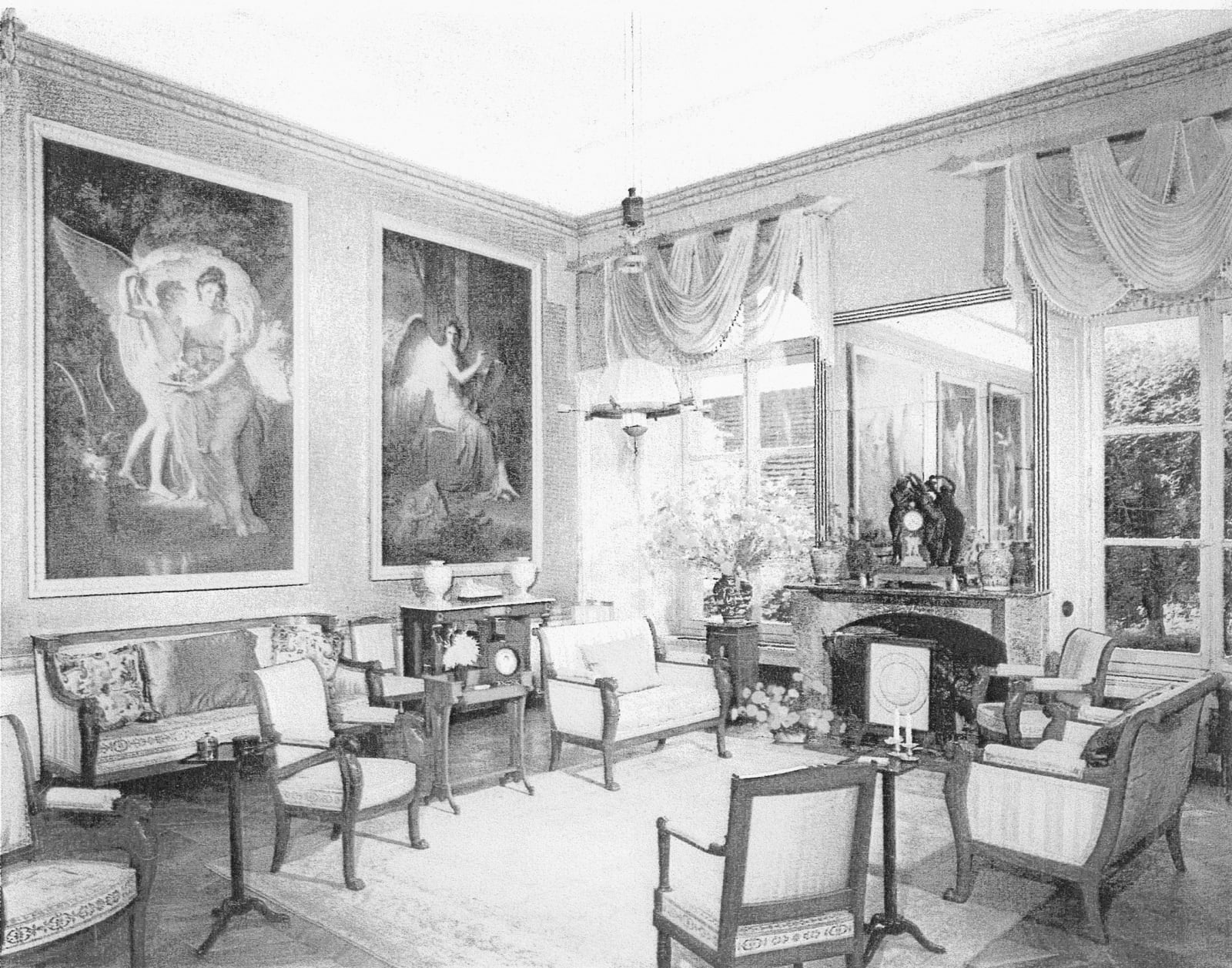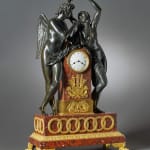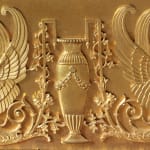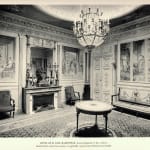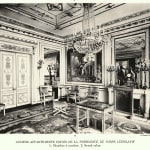
Hotel de M. Paul Marmottan, Avenue Raphaël No. 20, à Paris.
Grand Salon orné d'une tenture en grisaille, représentant l'histoire de Psyché.
See clock on the fireplace.

Anciens appartements privés de la Présidence du corps Législatif.
Grand Salon.
Claude Hémon
Further images
Literature
"Decorative bronzes of Pierre-Philippe Thomire”, 1984, p. 59, pl. 114, illustrating a near identical clock case by P.-P. Thomire. Hans Ottomeyer and Peter Pröschel, “Vergoldete Bronzen”, 1986, p. 350, pl. 5.7.1, illustrating a similar clock case of 1814 in the Ministère de la Guerre, Paris, and p. 669, illustrating a similar model of 1819 by Lucien-François Feuchère. Jean-Pierre Samoyault, “Pendules et Bronzes d’Ameublement Entrés Sous le Premier Empire”, 1989, p. 56, pl. 12, illustrating a similar clock case at Château de Fontainebleau. Pierre Kjellberg, “Encyclopédie de la Pendule Française du Moyen Age au XXe Siècle”, 1997, p. 402, illustrating a similar but simpler case without the additional mounts. Elke Niehüser, “Die Französische Bronzeuhr”, 1997, p. 210, pl. 270, illustrating a similar model.
A very beautiful Empire gilt and patinated bronze and rouge griotte marble figural clock of eight day duration by Claude Hémon and housed in a magnificent case by the bronzier Pierre-Victor Ledure, signed on the white enamel dial Ledure Bronzier à Paris and also Hémon hr . The dial with Roman numerals and a pair of blued steel pointers to indicate the hours and minutes. The movement with anchor escapement, silk thread suspension, striking on the hour and half hour on a single bell, with outside count wheel. The case featuring the figures Psyche to the right who bends inward as she crowns Cupid who stands on the other side of a domed rectangular rouge griotte marble plinth enclosing the dial, mounted below by a lyre issuing from a pair of cornucopias, the plinth raised on a gilt bronze step cast with a central vase flanked by a pair of swans, the figures and domed plinth on a comparable stepped rectangular marble base mounted with interlinked wreaths above a foliate border supported on winged lion paw feet
Paris, date circa 1815-20
Height 92 cm, width 56 cm, depth 29 cm.
This magnificent case featuring Psyche crowning Cupid by Pierre-Victor Ledure (1783-post 1840), is based on a model by the sculptor Claude Michallon (1751-99) of circa 1814. Ledure also produced cases of similar design including one housing a movement by Thomas à Paris, now in Schloss Ellingen, Germany as well as another sold by Sotheby's New York, 10th November 1986, lot 105. Near identical cases were also made by Pierre-Philippe Thomire (1751-1843) as well as Lucien-François Feuchère (fl. 1784-1824), who in 1816 sold a similar model entitled 'Pendule de Psyché couronnant l'Amour, groupe modelé par feu Michallon'. Feuchère also showed another example at the Exposition de Produits de l'Industrie, 1819. Other similar clock cases can be found at Château de Fontainebleau, the Ministère de la Guerre, the Ministère de la Marine and Musée de Marmottan in Paris as well as in the British royal collection at the Royal Pavilion, Brighton.
One of the clock's many appeals is that the dial features both the names of the clockmaker Claude Hémon (fl. 1770-1820) and the bronzier Pierre-Victor Ledure. In addition to clock cases, Ledure produced a variety of exceedingly fine candelabra, torchères, girandoles, centrepieces and guéridons in both the Empire and revived Renaissance style. Born in Paris in 1783, he was the son of Laurent Ledure and Marie-Marguérite née Lainé who died when he was only five in 1788, shortly before the French Revolution. Fortunately for Ledure he was apprenticed under the renowned bronzier, André-Antoine Ravrio (1759-1814); it was this association that was to prove one of the best forms of recommendation in later career. Ledure formed a close friendship with Ravrio and his adopted son, Louis-Stanislas Lenoir-Ravrio (1783-1846) who both acted as best men at his wedding in 1811. Ledure's wife, Geneviève was the daughter of a former gilder, Edme Dartois (d. 1796) while her brother, Jean-Edme was a bronzier who later shared a workshop with Ledure. During early married life Ledure worked from rue Neuve des Petits-Champs. In 1834, when he renamed the business Ledure et Cie, he moved to 16 rue Vivienne and then in 1836 he moved once more to 2 rue Vivienne.
Although Ledure was never employed directly by the Garde-Meuble he received many important commissions during the Empire period, enjoying the patronage from a wealthy international clientele, such as the Archduke of Tuscany, Duke of Franken, who in 1813 gave him a large order for bronze furnishings for his residence in Würzburg. The order included several fine figural clock cases such as one of a classical figure of Learning leaning against a podium. Another clock case of 1820, resembling a Greek temple, was made for the Duke of Wellington's home at Strafield Saye House, Hampshire. Ledure also secured a number of important contracts through Louis-Philippe's government which included the supply of elaborate candelabra and fleurons in the Renaissance style for the Throne Rooms of the Tuileries in 1835. The previous year his firm had also been employed to re-gild two bookstands in the Louis XIV Room at Versailles.
In addition to private commissions, Ledure gained repute through his successes at various national and international exhibitions. He was awarded a silver medal at the 1819 Exposition de l'Industrie, Paris and in 1834 the French Jury awarded his company a gold medal for its collection of Renaissance style clock cases and other works of art. Although Ledure's date of death is unknown he is mentioned in the trade papers from 1813 up until 1840. Today one can find examples of his work in many important private and public collections including the Museo de Reloges at Jerez de la Frontera, the Palais Vienna in Madrid, the Royal Pavilion at Brighton and also the British Embassy in Paris.
Ledure supplied a number of leading Parisian clockmakers with cases, among whom was Claude Hémon, who made the present movement. They enjoyed several collaborations together and again featured both their names on the dial of a pyramid-shaped clock surmounted by the figure of Renommée and also on the dial of another rouge griotte and gilt and patinated bronze case with a classical female figure. Movements by Hémon are known to have also been used by Pierre Philippe Thomire. One of Hémon's clocks housed in a gilt bronze case surmounted by the youthful figure of Pan is in the British Royal Collection at Holyroodhouse Palace in Edinburgh. Although only a few biographical facts are recorded we know that Hémon was received as a maître horloger in 1770 and that he ran his workshop at the rue Saint-Martin from 1812 to 1820.


